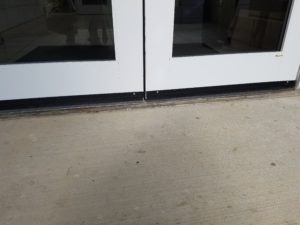How Tyler ISD transformed their environmental health program
by Janet Hurley, Extension Program Specialist III
Tyler ISD is a typical mid-sized school district in a suburban area; they are experiencing population growth. With that growth means new campuses and some unique problems. Like all public schools in Texas, Tyler adopted integrated pest management (IPM) in 1995 when the TX Legislature mandated all public schools to use better practices to managing pests, rather than spraying baseboards for perceived pests.
In 2014 Robert Grant was appointed Supervisor of Maintenance for Facilities Services. One of the best things that happened was that Robert Grant received training before he began to run a growing district. During the transition time, Tyler built a couple of new schools. In September 2013 AgriLife Extension hosted a school IPM workshop and toured the Elementary campus as part of school IPM training, at TISD when we first met Robert. At that time, we had noticed that the door sweeps were in place but not the best of the line. They also had vegetation growing near the building, but the school was only three years old, so pests weren’t yet a problem.
As time moved forward this campus had an increase of students and the surrounding neighborhood also under went improvements as well. At the same time, the weather changed from drought to flooding. When the campus was built in 2010, it was built on a hill that required a storm drain that ran under the structure to a creek 1000 feet behind the campus. The sudden increase in moisture brought about an increase in slithering and crawling critters.
As the district was working out a solution for their ongoing IPM problems in the fall of 2015, a local
inventor named Brandon Johnston stopped by to talk to Robert Grant and Mark Manning, non-commercial pesticide applicator for Tyler ISD, about the products he invented for pest and disease prevention, called SEAL-N-KILL and FASST SEAL. Johnston lives in Gilmer, TX and recently was interviewed by a local TV station KETK about this “new” product that can help keep germs and ants away. SEAL-N-Kill is an antimicrobial copper that is impregnated onto a film that can cover push plate door handles and can be cut to accommodate other types of door surfaces where people touch and transfer microorganisms. FASST SEAL is door sweep seal, but instead of just being made of plastic, this product is made with terpenes, geraniol and polymers to keep the “plastic seal” in tack. Terpenes and geraniol, allow the seal to be infused with green repellants making this something new and unique in the marketplace.
Robert and Mark decided to pilot the products on their Jones-Boshears Campus. The Jones-Boshears school integrates two unique programs into one modern facility, allowing for shared use, cross-pollination and reduced infrastructure costs. The Wayne D. Boshears Center for Exceptional Programs specializes in providing services to students who have unique challenges due to severe and profound disabilities. Jones Elementary School campus was combined with Boshears when they built this new campus to accommodate the growing student population in the area. Since these are two separate campuses on one piece of property, the maintenance and operations department still had about 80,000 sq. ft. per campus to clean, keep pests out and ensure student safety.
In October 2015, Tyler ISD implemented the SEAL-N-KILL and FASST SEAL products to see if the products would reduce sightings of ants and snakes. Robert and Mark also wanted to see if the anti-microbial film would reduce germs on the campus. In July 2016, I made a trip to Tyler to review the campus and to see what I could learn about these products as well.
During the fall of 2015, Mark Manning worked with Brandon Johnston to install door sweeps and the film transfer on all the exterior doors. The chief complaint for both campuses was small snakes and ants. Snakes are never a good mix with students and staff; even the garden variety snake typically makes most people feel queasy. As for the door handles, Robert wasn’t sure about the reducing the germs, but he wanted to see if it helped.
After 6 months in the field using the Seal-N-Kill Push Plate Covers, Johnston removed push plate covers from push plates on an active main corridor swinging door. The samples were tested for Staphylococcus aureus 6538 reduction over the standard 24-hour incubation test period to confirm antimicrobial activity. When the film was installed, it was rated at 99.9999% effective against S. aureus. After 6 months the test results came back at 99.9998% effective against the same bacteria. In other words, after 6 months the film was still killing bacteria. Unfortunately, we couldn’t really track student absence reduction, but Robert and Mark said that they are happy that both principals have been very happy with the “pest” reduction.
While I was visiting with Robert in July, he decided that he was going to expand this program throughout the district. As door sweeps need replacing, his goal is to switch to the FASST SEAL sweeps. Grant stated, “This just gives one more layer of insurance to not have ants, snakes, crickets or anything else crawling under a door. As the district grows we are striving to keep up with the campuses, the new pests and everything else you have to do just to keep school campuses safe, this is just another tool in our toolbox.”
Integrated pest management (IPM) is managing pests at acceptable level, using multiple control tactics. Each and every tactic has its place in the IPM toolbox; Tyler just found a new tool to use. Over the next year AgriLife Extension will be keeping track of the schools that use these two products to see if we learn more about student health and teacher satisfaction.
Want to share this story with others, download a copy here. Linking IPM to School Health





 .
.